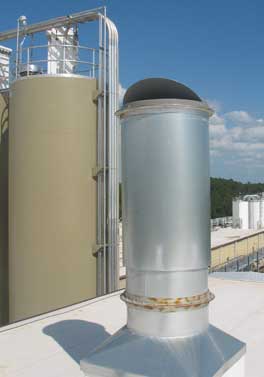 REQUEST QUOTE
REQUEST QUOTEMany industrial processes and other stationary sources discharge visible emissions into the atmosphere. Such visible emissions, or opacity, are caused by fine particulate matter and aerosol in the exhaust; the smaller the particle size, the greater the opacity. The fine particulate and aerosol emissions may be solid phase particulate, condensed (i.e., liquid) phase particulate, or a combination of both. Opacity levels are regulated by federal and state/provincial agencies, typically to a level of 20%, or less in some cases.
APC Technologies, Inc.’s Ultra High-Efficiency Filter (UHF®) systems are ideal for opacity removal and have been used for same in many different industries. The UHF® system uses a proven design to remove very fine particulate, both condensed and solid phase, including oil mist, smoke, haze, and condensed acid mists (e.g., H2SO4), with control efficiency of up to and in excess of 99% including sub-micron size particulate. Applications range down to particle sizes of less than 0.05 micron. Typical UHF® system installations have zero opacity. When the particulate is sticky, oily, or contains free water, the UHF® is even more advantageous as the UHF® has no issues with blinding or plugging.
For many combustion applications, condensable sulfuric acid (H2SO4) aerosols are the major cause of excess opacity. The UHF® system is offered in corrosion-resistant materials and will remove the fine sulfuric acid mist and resultant opacity with ease.
For select applications, APC’s Dry Scrubbers/Coated Baghouses or VP Series Venturi Scrubbers may also be well-suited for opacity control. Additional contaminants besides fine particulate can also be addressed with APC’s coated baghouses, including gas-phase contaminants such as SOx, other acid gases, mercury, and VOCs, through the use of various injected sorbents.
To date include the following industries and applications: adhesives, aluminum rolling mills, other aluminum fabrication plants, asphalt plants and terminals, bakeries, biomass furnaces, chemical plants, coating operations, coffee production, composites, drying ovens, food processing, furniture manufacture, foundries, kilns (all types), lubricant production, oil pipeline terminals, oil refineries, painting operations, petrochemical plants, plastics, polymers, printing, pulp and paper manufacture, metals fabrication, recycling plants, rendering, resins, roofing products, rubber products, pharmaceuticals, sealants, solar power plants, spray drying operations, textile finishing, tire operations, and others.